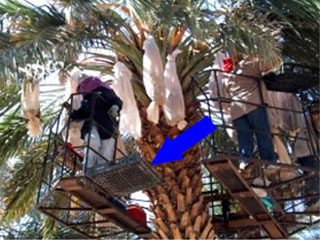Dates have been cultivated in the Middle East for over 5,000
years and are mentioned in the Bible, the Torah and the Qur’an. They are a
sweet, nutritious delicacy integral to Eastern diets and cultural traditions.
The Coachella Valley is the primary date growing region in
North America. The life cycle of the date palm is unusual and fascinating.
Date farming is a year round operation requiring skilled workers.
Date farming is a year round operation requiring skilled workers.
Just as every time a child is born a new, different person
is brought into the world, date seeds do not create an identical new tree. Nature
has never repeated people nor has she repeated dates grown from seeds.
Male and female date palms produce offshoots of their own
sex, which will be identical to their ancestors. These offshoots are removed
from the parent tree and transplanted in order to maintain the same variety and
quality of fruit.
“A date palm must have its feet in the water and it head in
the fires of Heaven” is an old world saying. It requires as much water as a
willow tree but only at its roots.
Date palms have 4 to 5 inch thorns, which are removed from
the trees in January and February.
New palms are planted at 48 females to one male per acre. Full
fruit production will not be reached until 10 to 15 years after planting.
Nature did not make date flowers appealing to birds so workers manually pollinate each female
blossom.
In July the date bunches are covered with cloth or paper
bags to protect them from rain and birds. The bags also collect early ripening
dates before they fall to the ground.
Depending upon the moisture content of the date varieties
they are harvested mechanically or by hand from August to Christmas. Manual
harvesting is conducted by ladders attached to the trees or with a U shaped basket on a forklift.
Harvest time can be extremely hot. Workers wear protective gear to shield them from the heat and the thorns.
When the palms become too tall for safe harvesting the farms
are abandoned.
We have always enjoyed eating dates but now we have a
greater appreciation of growing the most expensive crop in the world.
















Holy smokes, you could write a book on this stuff. Who knew? You do apparently. Very interesting stuff here.
ReplyDelete